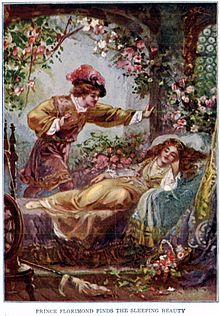
Back A bonica adormida d'a selva AN الجميلة النائمة Arabic শ্লীপিং বিউটী Assamese Yatmış gözəl (nağıl) Azerbaijani Спячая прыгажуня Byelorussian Прыгажуня ў сонным лесе BE-X-OLD Спящата красавица (приказка) Bulgarian স্লিপিং বিউটি Bengali/Bangla Ar Goantenn e Koad ar C'housk Breton La Bella Dorment (conte) Catalan
| The Sleeping Beauty | |
|---|---|
 The prince finds the Sleeping Beauty, in deep slumber amidst the bushes. | |
| Folk tale | |
| Name | The Sleeping Beauty |
| Also known as | La Belle au bois dormant (The Beauty Sleeping in the Wood); Dornröschen (Little Briar Rose) |
| Aarne–Thompson grouping | ATU 410 (Sleeping Beauty) |
| Region | France (1528) |
| Published in |
|
| Related | |
"Sleeping Beauty" (French: La Belle au bois dormant, or The Beauty Sleeping in the Wood[1][a]; German: Dornröschen, or Little Briar Rose), also titled in English as The Sleeping Beauty in the Woods, is a fairy tale about a princess cursed by an evil fairy to sleep for a hundred years before being awakened by a handsome prince. A good fairy, knowing the princess would be frightened if alone when she wakes, uses her wand to put every living person and animal in the palace and forest asleep, to awaken when the princess does.[6]
The earliest known version of the tale is found in the narrative Perceforest, written between 1330 and 1344.[7] Another was the Catalan poem Frayre de Joy e Sor de Paser.[8] Giambattista Basile wrote another, "Sun, Moon, and Talia" for his collection Pentamerone, published posthumously in 1634-36[9] and adapted by Charles Perrault in Histoires ou contes du temps passé in 1697. The version collected and printed by the Brothers Grimm was one orally transmitted from the Perrault version,[10] while including own attributes like the thorny rose hedge and the curse.[11]
The Aarne-Thompson classification system for fairy tales lists Sleeping Beauty as a Type 410: it includes a princess who is magically forced into sleep and later woken, reversing the magic.[12] The fairy tale has been adapted countless times throughout history and retold by modern storytellers across a variety of media.
- ^ Anita Moss (1986). The Family of Stories: An Anthology of Children's Literature. Holt, Rinehart and Winston. p. 90. ISBN 978-0-03-921832-4.
- ^ F. P. Terzuolo (1864). Études sur le Dictionnaire de l'Académie Française (in French). p. 62.
[...] exactement comme on dit : La Belle au bois dormant, ce qui ne veut pas dire la belle au bois qui dort, mais la belle qui dort au bois [...]
- ^ Léopold Constans (1890). Chrestomathie de l'ancien français (IXe-XVe siècles) (in French). p. 15.
- ^ Linguist. Vol. 13. 1951. p. 92.
- ^ Larive & Fleury (1888). La troisième année de grammaire (in French). p. 148.
- ^ "410: The Sleeping Beauty". Multilingual Folk Tale Database. Retrieved February 26, 2019.
- ^ Uther, Hans-Jorg (2004). The Types of International Folktales: A Classification and Bibliography. Helsinki: Suomalainen Tiedeakatemia. pp. 244–245.
- ^ Zago, Ester (1991). ""Frayre de Joy e Sor de Plaser" Re-Examined". Merveilles & Contes. 5 (1): 68–73. JSTOR 41390275.
- ^ Hallett, Martin; Karasek, Barbara, eds. (2009). Folk & Fairy Tales (4 ed.). Broadview Press. pp. 63–67. ISBN 978-1-55111-898-7.
- ^ Bottigheimer, Ruth. (2008). "Before Contes du temps passe (1697): Charles Perrault's Griselidis, Souhaits and Peau". The Romantic Review, Volume 99, Number 3. pp. 175–189.
- ^ "The Original Sleeping Beauty: A Journey Through the Dark Roots of a Beloved Tale - Magical Clan". 14 November 2023.
- ^ Aarne, Antti; Thompson, Stith. The types of the folktale: a classification and bibliography. Folklore Fellows Communications FFC no. 184. Helsinki: Academia Scientiarum Fennica, 1961. pp. 137–138.
Cite error: There are <ref group=lower-alpha> tags or {{efn}} templates on this page, but the references will not show without a {{reflist|group=lower-alpha}} template or {{notelist}} template (see the help page).
© MMXXIII Rich X Search. We shall prevail. All rights reserved. Rich X Search